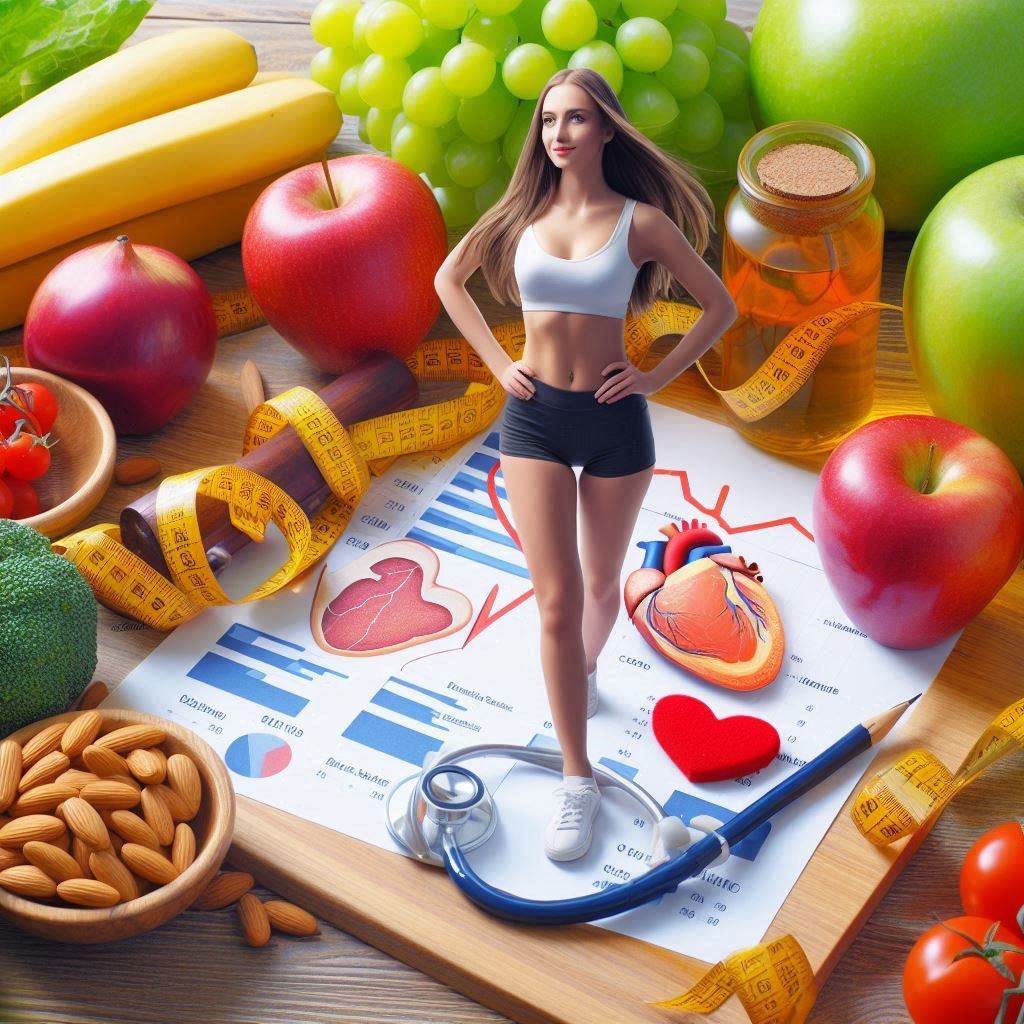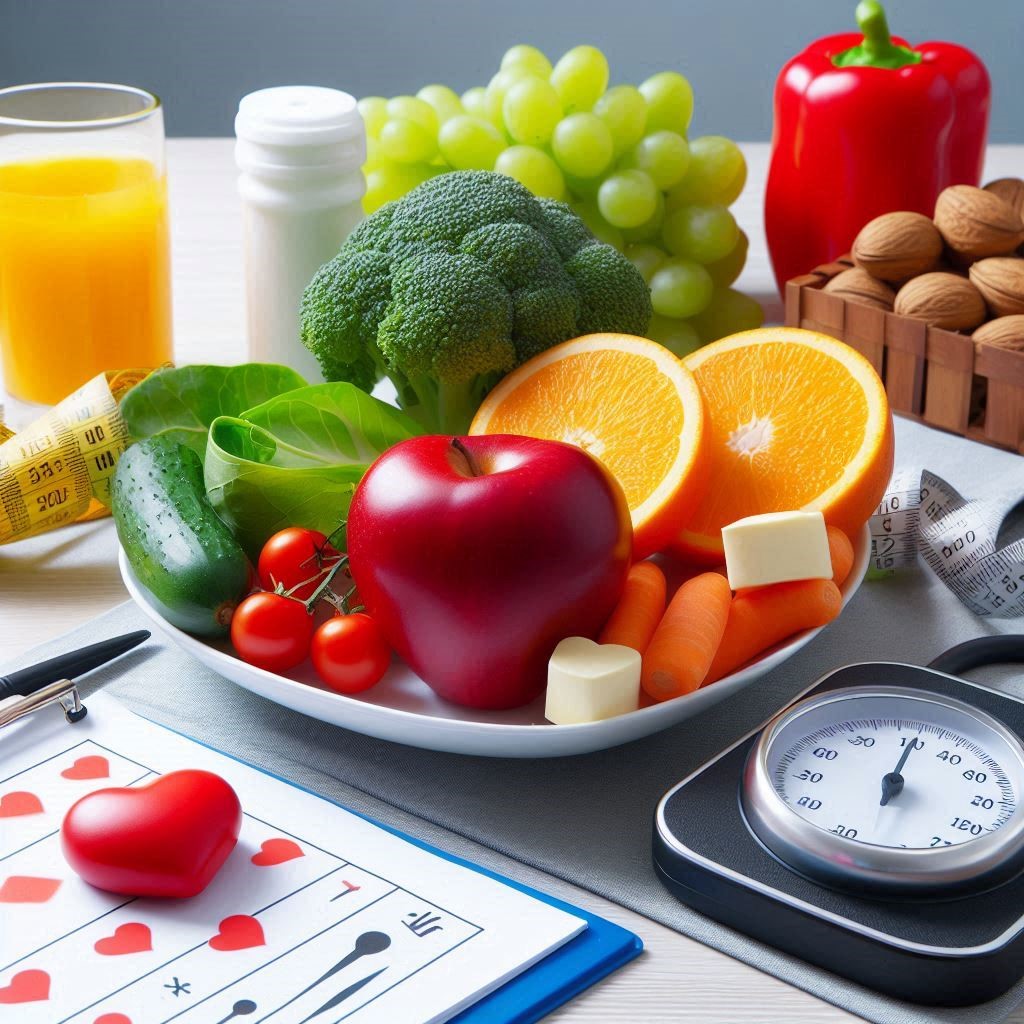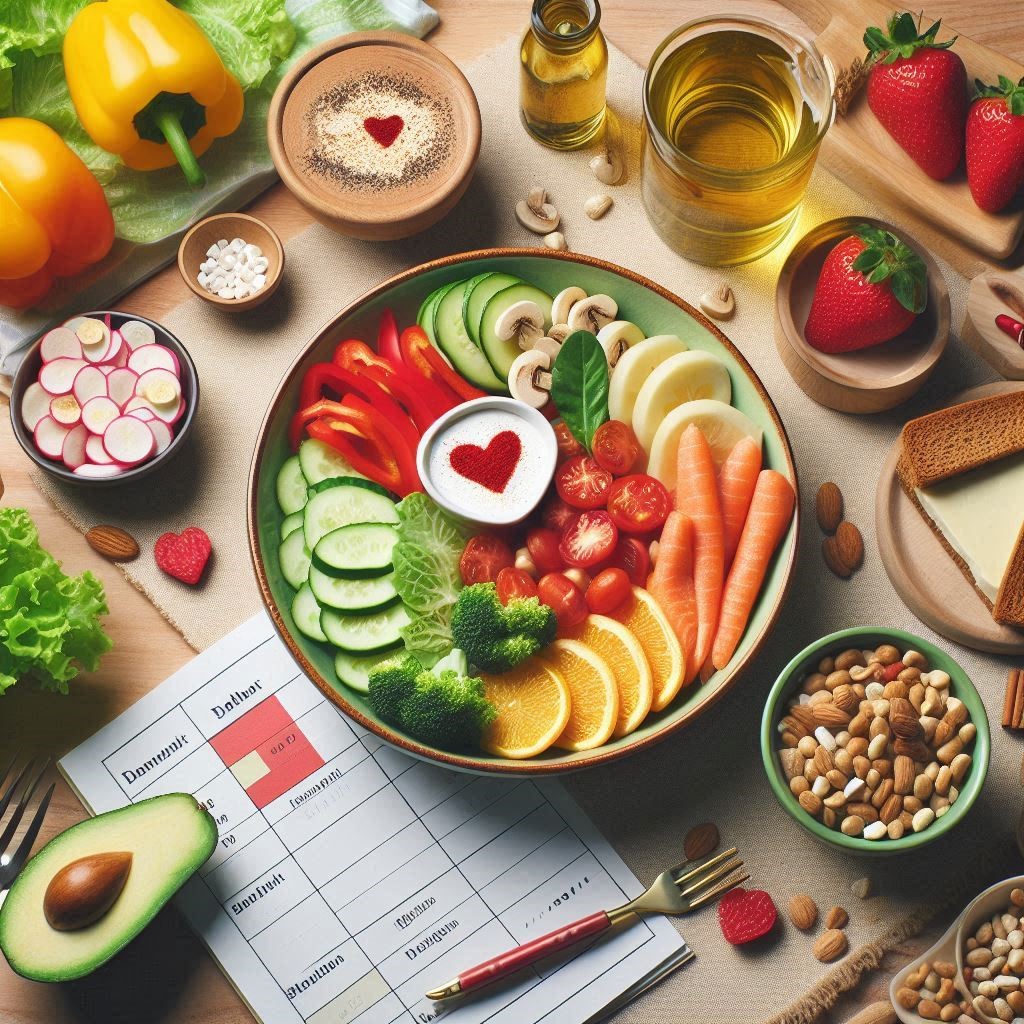
Diet to Lower Cholesterol and Lose Weight: A Comprehensive Guide
Diet to Lower Cholesterol and Lose Weight: Managing cholesterol and weight is crucial for maintaining overall health and reducing the risk of cardiovascular diseases. A strategic diet can help achieve both goals by incorporating foods that lower bad cholesterol (LDL) and promote weight loss. This guide provides an in-depth look at the most effective dietary strategies to manage cholesterol and achieve a healthy weight.
Understanding Cholesterol
Cholesterol is a waxy substance found in your blood, essential for building cells but potentially harmful in excess. There are two types of cholesterol:
- Low-density lipoprotein (LDL): Known as bad cholesterol, high levels can lead to plaque buildup in arteries.
- High-density lipoprotein (HDL): Known as good cholesterol, it helps remove LDL cholesterol from the bloodstream.
Maintaining a balance between these types is key to cardiovascular health.
Key Nutrients for Lowering Cholesterol
Several nutrients play a significant role in lowering cholesterol levels:
- Soluble Fiber: Found in oats, beans, lentils, fruits, and vegetables, soluble fiber helps reduce LDL cholesterol by binding to it in the digestive system and preventing its absorption.
- Omega-3 Fatty Acids: These are present in fatty fish like salmon, mackerel, and sardines, as well as in walnuts and flaxseeds. They help lower triglyceride levels and increase HDL cholesterol.
- Plant Sterols and Stanols: Plant sterols and stanols play a key role in cholesterol management. These compounds, found in certain fortified foods and supplements, block cholesterol absorption in the intestines, thereby helping to reduce overall cholesterol levels.
- Monounsaturated and Polyunsaturated Fats: These healthy fats, found in olive oil, avocados, and nuts, can lower LDL cholesterol levels and improve heart health.

Foods That Lower Cholesterol Fast
Incorporating certain foods into your diet can quickly impact cholesterol levels:
- Oats and Barley: These grains are rich in soluble fiber.
- Nuts and Seeds: Almonds, walnuts, and flaxseeds provide healthy fats and fiber.
- Fatty Fish: Salmon, mackerel, and sardines are high in omega-3 fatty acids.
- Fruits and Vegetables: Apples, oranges, pears, and berries are high in fiber and antioxidants.
- Legumes: Beans, lentils, and chickpeas are excellent sources of soluble fiber and protein.
Foods to Avoid with High Cholesterol
To manage cholesterol effectively, it’s important to limit or avoid foods that can increase LDL levels:
- Trans Fats: Found in processed foods like baked goods, snacks, and margarine, trans fats can significantly raise LDL cholesterol.
- Saturated Fats: High in red meat, butter, and full-fat dairy products, saturated fats can increase overall cholesterol levels.
- Refined Sugars and Carbohydrates: Excessive sugar and refined carbs can lead to weight gain and higher triglyceride levels.
- Excessive Salt: While salt does not directly impact cholesterol, high sodium intake can raise blood pressure and increase cardiovascular risk.
Effective Diet Plans for Lowering Cholesterol and Losing Weight
Several dietary approaches can help manage cholesterol and promote weight loss:
- Mediterranean Diet: Emphasizes fruits, vegetables, whole grains, fatty fish, and healthy fats like olive oil. It’s associated with lower cholesterol levels and improved heart health.
- DASH Diet: Focuses on reducing sodium intake and eating nutrient-rich foods like fruits, vegetables, whole grains, and lean proteins. It’s effective for both cholesterol management and weight loss.
- Vegetarian and Vegan Diets: These diets are typically high in fiber and low in saturated fats, making them effective for lowering cholesterol and promoting weight loss.
Practical Tips for Incorporating Cholesterol-Lowering Foods
- Breakfast: Start your day with oatmeal topped with fruit and nuts.
- Snacks: Choose fruits, vegetables, and nuts instead of processed snacks.
- Meals: Include a serving of fatty fish like salmon at least twice a week. Add legumes and whole grains to your meals.
- Cooking: Use olive oil instead of butter or margarine.
Diet to Lower Cholesterol and Lose Weight: Cultural Dietary Approaches

Adopting a diet to lower cholesterol and lose weight can be both effective and culturally enriching. Different cultural dietary approaches offer unique, flavorful ways to maintain heart health and achieve weight management. Moreover, these diverse culinary traditions can provide a wealth of nutritional benefits. Consequently, exploring various cultural diets can be both enjoyable and beneficial for one’s health. Therefore, let’s take a closer look at various cultural diets that can help in this endeavor:
1. Mediterranean Diet
The Mediterranean diet is renowned for its heart-healthy benefits and effectiveness in promoting weight loss. Specifically, it is characterized by a high intake of fruits, vegetables, whole grains, nuts, and olive oil. Here’s how these components, in particular, contribute to lowering cholesterol and aiding weight loss:
Fruits and Vegetables:
Rich in fiber, vitamins, and antioxidants, these foods help reduce LDL (bad cholesterol) levels and support overall cardiovascular health.
Whole Grains:
In particular, whole grains play a crucial role in a heart-healthy diet. For instance, foods like whole wheat, oats, and barley are full of fiber. Consequently, this high fiber content helps in managing cholesterol levels. Moreover, these grains have the added benefit of keeping you fuller longer, thus aiding in weight control. Therefore, incorporating a variety of whole grains into your diet can support both cardiovascular health and weight management goals.
Nuts and Seeds:
Specifically, almonds, walnuts, and flaxseeds are packed with healthy fats and protein. As a result, these nutrient-dense foods help in lowering cholesterol and managing appetite. Furthermore, their inclusion in a balanced diet can contribute to overall heart health.
Olive Oil:
In particular, olive oil is a staple of the Mediterranean diet. Notably, it is rich in monounsaturated fats. Consequently, these beneficial fats can help reduce bad cholesterol levels. Moreover, olive oil can support weight loss efforts when used as part of a balanced diet.
Including culturally specific recipes can make adhering to the Mediterranean diet more enjoyable and sustainable. Here are a few examples:
- Greek Salad: A fresh mix of tomatoes, cucumbers, olives, and feta cheese dressed with olive oil and lemon juice. This salad is a nutrient-dense, low-calorie dish that supports both cholesterol management and weight loss.
- Falafel: Made from chickpeas, falafel is a protein-rich, fiber-packed food that can be baked instead of fried to reduce calorie intake while providing satiety and nutrients.
- Tabbouleh: Additionally, tabbouleh, a traditional Middle Eastern dish, offers numerous health benefits. Specifically, this salad made from bulgur, parsley, mint, tomatoes, and cucumbers is a great source of fiber and antioxidants. Consequently, it contributes to lower cholesterol levels. Moreover, due to its low-calorie and nutrient-dense nature, tabbouleh aids in weight control. Therefore, incorporating this dish into one’s diet can support both heart health and weight management goals.
2. Asian Diet
The traditional Asian diet, especially from regions like Japan, China, and Korea, offers a variety of heart-healthy and weight-friendly options:
- Fish and Seafood: Furthermore, certain types of fish are particularly beneficial for heart health and weight management. Specifically, fish like salmon and mackerel are high in omega-3 fatty acids. As a result, these fatty fish help lower cholesterol levels. Additionally, they support weight loss efforts due to their protein content and ability to promote satiety.
- Soy Products: Foods like tofu and edamame are high in protein and low in saturated fats, contributing to cholesterol reduction and weight management.
- Green Tea: A staple in many Asian diets, green tea is known for its antioxidant properties and potential to boost metabolism.
Culturally specific dishes that align with these principles include:
- Sushi: When made with fresh fish, vegetables, and minimal rice, sushi can be a low-calorie, nutrient-dense option.
- Stir-Fried Vegetables: Using minimal oil, stir-frying vegetables like bok choy, bell peppers, and broccoli preserves their nutrients while keeping the dish low in calories.
- Miso Soup: A traditional Japanese soup made with fermented soybean paste, miso soup is low in calories and high in beneficial probiotics.
3. Latin American Diet
Furthermore, the traditional Latin American diet offers numerous health benefits. Specifically, this culinary tradition incorporates a variety of fruits, vegetables, legumes, and whole grains. As a result, these nutrient-rich foods are essential for promoting heart health. Additionally, their high fiber content and low calorie density make them beneficial for weight loss. Therefore, let’s explore some key components of this diet:
- Beans and Legumes: Furthermore, legumes are an essential component of many heart-healthy diets. Specifically, foods like black beans and lentils are rich in fiber and protein. As a result, these nutrient-dense legumes help lower cholesterol levels. Additionally, due to their high fiber and protein content, they keep you full longer. Consequently, incorporating legumes into your meals can support both cardiovascular health and weight management efforts.
- Avocado: High in healthy monounsaturated fats, avocados can help reduce bad cholesterol levels.
- Corn and Whole Grains: Staples like corn and quinoa are good sources of fiber and nutrients, supporting both cholesterol management and weight control.
Examples of culturally specific recipes include:
- Guacamole: Made from avocados, lime, and tomatoes, guacamole is a nutrient-rich, heart-healthy option when eaten in moderation.
- Ceviche: A dish made from fresh fish marinated in citrus juices, often combined with tomatoes, onions, and cilantro, offering a low-calorie, high-protein meal.
- Black Bean Soup: A hearty, fiber-rich soup that can be a filling and nutritious meal, supporting both weight loss and cholesterol reduction.
4. Indian Diet
The traditional Indian diet, with its focus on spices, legumes, and whole grains, can also support heart health and weight management:
- Spices: Turmeric, ginger, and garlic are known for their anti-inflammatory and cholesterol-lowering properties.
- Legumes: Lentils and chickpeas are high in fiber and protein, promoting satiety and helping in cholesterol management.
- Whole Grains: Foods like brown rice and whole wheat are integral to the Indian diet and support sustained energy levels and weight control.
Culturally specific dishes that align with these principles include:
- Lentil Curry (Dal): A rich source of protein and fiber, lentil curry is both satisfying and nutritious.
- Vegetable Samosas: When baked instead of fried, samosas made with whole grain wrappers and filled with vegetables can be a healthier alternative.
- Chana Masala: A chickpea-based dish that is high in fiber and protein, supporting both cholesterol reduction and weight management.
Exploring these cultural dietary approaches can provide flavorful and effective strategies for lowering cholesterol and losing weight. Whether you choose the Mediterranean, Asian, Latin American, or Indian diet, focusing on whole, nutrient-dense foods and traditional recipes can support your health goals while adding diversity to your meals.
Feel free to ask if you need more information or details on any of these dietary approaches!
Personalized Meal Plans for a Diet to Lower Cholesterol and Lose Weight

Creating personalized meal plans tailored to individual caloric needs and dietary preferences is crucial for effectively following a diet to lower cholesterol and lose weight. This guide provides options based on daily caloric intake and accommodates various dietary preferences such as vegetarian, vegan, and gluten-free diets.
1. Meal Plans Based on Caloric Needs
Developing meal plans that fit different caloric needs helps ensure that you can maintain a balanced intake while working toward lowering cholesterol and losing weight. Below are examples of meal plans for 1200, 1500, and 2000 calorie diets, with options for breakfast, lunch, dinner, and snacks.
1200 Calorie Plan
- Breakfast:
- Greek Yogurt Parfait: 1 cup of low-fat Greek yogurt topped with mixed berries and a sprinkle of chia seeds. This combination provides protein and fiber, aiding in satiety and cholesterol management.
- Lunch:
- Spinach and Quinoa Salad: Mixed greens with quinoa, cherry tomatoes, cucumber, and a lemon-olive oil dressing. Adding nuts like almonds or walnuts boosts heart-healthy fats.
- Dinner:
- Baked Salmon with Steamed Vegetables: A portion of baked salmon seasoned with herbs, served with a side of steamed broccoli and carrots. Salmon is rich in omega-3 fatty acids, beneficial for lowering cholesterol.
- Snacks:
- Apple Slices with Almond Butter: Slices of apple paired with a tablespoon of almond butter provide a nutritious, filling snack.
1500 Calorie Plan
- Breakfast:
- Oatmeal with Fresh Fruit: ½ cup of rolled oats cooked with water or almond milk, topped with sliced bananas and a handful of blueberries. Oats are high in soluble fiber, which helps reduce cholesterol levels.
- Lunch:
- Chickpea and Avocado Wrap: A whole-grain wrap filled with mashed avocado, chickpeas, shredded lettuce, and diced tomatoes. This vegan option is rich in fiber and healthy fats.
- Dinner:
- Grilled Chicken with Roasted Vegetables: A serving of grilled chicken breast with a side of roasted bell peppers, zucchini, and sweet potatoes. This meal is balanced in protein and fiber, supporting weight loss and heart health.
- Snacks:
- Carrot Sticks with Hummus: Fresh carrot sticks paired with 2 tablespoons of hummus provide a crunchy, satisfying snack.
2000 Calorie Plan
- Breakfast:
- Avocado Toast with Egg: Whole grain toast topped with mashed avocado and a poached or scrambled egg. Avocado provides healthy fats, while the egg adds protein.
- Lunch:
- Turkey and Spinach Wrap: A whole grain wrap filled with sliced turkey, spinach, red bell pepper, and a light spread of mustard. This meal offers lean protein and fiber.
- Dinner:
- Vegetable Stir-Fry with Brown Rice: A mix of colorful vegetables like bell peppers, broccoli, and snap peas stir-fried with a splash of soy sauce, served over brown rice. This dish is low in fat and high in nutrients.
- Snacks:
- Mixed Nuts and Dried Fruit: A small handful of unsalted mixed nuts and a few pieces of dried fruit provide a good balance of protein, fats, and natural sugars.
2. Variations for Dietary Preferences
Personalizing meal plans to suit dietary preferences ensures that everyone can follow a diet to lower cholesterol and lose weight, regardless of their specific dietary needs. Here are variations for vegetarian, vegan, and gluten-free diets.
Vegetarian Options
- Breakfast:
- Vegetarian Smoothie Bowl: Blend spinach, banana, and almond milk, and top with granola, chia seeds, and fresh berries. This is a nutrient-packed way to start the day.
- Lunch:
- Vegetarian Stuffed Peppers: Bell peppers stuffed with a mix of quinoa, black beans, corn, and spices, baked until tender. This meal is high in fiber and protein.
- Dinner:
- Vegetable and Tofu Stir-Fry: Tofu stir-fried with an assortment of vegetables like broccoli, bell peppers, and mushrooms, served over brown rice. Tofu is a great source of plant-based protein.
Vegan Options
- Breakfast:
- Chia Seed Pudding: Chia seeds soaked overnight in almond milk, topped with fresh fruit and a drizzle of maple syrup. This is a fiber-rich, cholesterol-lowering breakfast.
- Lunch:
- Vegan Buddha Bowl: A bowl filled with brown rice, roasted chickpeas, avocado, spinach, and a tahini dressing. This meal is balanced with healthy fats and proteins.
- Dinner:
- Lentil and Vegetable Stew: A hearty stew made with lentils, carrots, celery, and tomatoes, seasoned with cumin and turmeric. Lentils are excellent for lowering cholesterol and supporting weight loss.
Gluten-Free Options
- Breakfast:
- Avocado Toast on Gluten-Free Bread: Gluten-free toast topped with mashed avocado, cherry tomatoes, and a sprinkle of sea salt. Avocado is rich in monounsaturated fats, which help lower bad cholesterol.
- Lunch:
- Quinoa Salad: A gluten-free salad with quinoa, mixed greens, cucumbers, and a lemon vinaigrette. Quinoa is a complete protein and naturally gluten-free.
- Dinner:
- Baked Sweet Potato with Black Beans: A baked sweet potato stuffed with seasoned black beans, corn, and a sprinkle of cilantro. This meal is rich in fiber and nutrients, promoting heart health.
Creating personalized meal plans for a diet to lower cholesterol and lose weight involves considering both caloric needs and dietary preferences. By offering a variety of options tailored to different calorie levels and dietary restrictions, you can enjoy diverse, nutrient-dense meals that support your health goals. Whether you follow a vegetarian, vegan, or gluten-free diet, these meal plans provide delicious and effective ways to lower cholesterol and manage weight.
If you have any specific dietary requirements or need more customized meal plans, feel free to ask!
Detailed Exercise Integration Plans for a Diet to Lower Cholesterol and Lose Weight

Integrating regular exercise with a diet to lower cholesterol and lose weight enhances overall health outcomes significantly. Exercise not only aids in weight management but also plays a crucial role in improving cholesterol levels. Below are detailed weekly exercise plans and explanations on how different types of exercises contribute to cholesterol management and weight loss.
1. Weekly Exercise Plans
Combining aerobic exercises with strength training is essential for a balanced approach to lowering cholesterol and promoting weight loss. Here’s a detailed weekly exercise plan that includes both types of exercises:
Weekly Plan Overview
- Days 1, 3, 5: Aerobic Exercise (30-60 minutes)
- Days 2, 4, 6: Strength Training (30-45 minutes)
- Day 7: Active Recovery/Rest
Day 1: Aerobic Exercise
- Brisk Walking: 30 minutes of brisk walking at a pace that raises your heart rate. Walking is a low-impact exercise that helps burn calories and improve cardiovascular health.
- Benefits: Walking regularly can help lower LDL (bad cholesterol) and increase HDL (good cholesterol), contributing to better cholesterol management and aiding in weight loss.
Day 2: Strength Training
- Full-Body Workout:
- Squats: 3 sets of 12-15 reps
- Push-ups: 3 sets of 10-12 reps
- Dumbbell Rows: 3 sets of 12 reps each side
- Planks: 3 sets of 30-60 seconds
- Benefits: Strength training builds muscle, which increases metabolism and helps burn more calories even at rest. It also improves insulin sensitivity, which is beneficial for maintaining healthy cholesterol levels.
Day 3: Aerobic Exercise
- Cycling: 45 minutes of moderate to vigorous cycling, either on a stationary bike or outdoors.
- Benefits: Cycling is an excellent way to boost cardiovascular fitness and burn significant calories, aiding in weight loss and improving lipid profiles by reducing LDL cholesterol and triglycerides.
Day 4: Strength Training
- Upper Body Focus:
- Dumbbell Chest Press: 3 sets of 12-15 reps
- Bicep Curls: 3 sets of 12-15 reps
- Shoulder Press: 3 sets of 12-15 reps
- Tricep Dips: 3 sets of 10-12 reps
- Benefits: Targeting the upper body helps build lean muscle mass, enhancing overall body composition and supporting metabolic health, which is crucial for managing cholesterol and body weight.
Day 5: Aerobic Exercise
- Swimming: 30-45 minutes of continuous swimming at a comfortable pace.
- Benefits: Swimming provides a full-body workout that improves cardiovascular fitness, promotes weight loss, and is easy on the joints. It also helps in increasing HDL cholesterol and lowering LDL cholesterol.
Day 6: Strength Training
- Lower Body Focus:
- Lunges: 3 sets of 12 reps each leg
- Leg Press: 3 sets of 12-15 reps
- Calf Raises: 3 sets of 15-20 reps
- Leg Curls: 3 sets of 12-15 reps
- Benefits: Focusing on lower body strength enhances muscle tone and endurance in the legs and glutes. Stronger muscles improve mobility and support cardiovascular health, contributing to better weight management and cholesterol levels.
Day 7: Active Recovery/Rest
- Activities: Light yoga, stretching, or a leisurely walk.
- Benefits: Active recovery helps reduce muscle soreness, improves flexibility, and maintains blood flow without stressing the body. Rest is crucial for muscle repair and overall recovery.
2. Exercise Benefits for Cholesterol and Weight Management
Regular exercise has profound effects on cholesterol levels and weight management. Here’s how:
Impact on Cholesterol Levels
- Increasing HDL (Good Cholesterol): Aerobic exercises like brisk walking, cycling, and swimming are particularly effective in raising HDL cholesterol levels. HDL cholesterol helps remove excess cholesterol from the bloodstream and transport it to the liver for excretion, thus reducing the risk of plaque buildup in arteries.
- Lowering LDL (Bad Cholesterol): Exercise helps lower LDL cholesterol by increasing the activity of enzymes that help transport LDL from the bloodstream to the liver, where it can be processed and eliminated. Activities such as cycling, jogging, and swimming can effectively reduce LDL levels.
- Reducing Triglycerides: Regular physical activity lowers triglyceride levels, which are fats in the blood that, in high amounts, can increase the risk of heart disease. Both aerobic and resistance exercises are effective in reducing triglycerides.
Impact on Weight Loss
- Caloric Burn and Metabolism: Aerobic exercises burn calories during the activity, while strength training increases muscle mass, which boosts metabolism and helps burn more calories throughout the day. This dual approach is essential for effective weight loss.
- Fat Reduction: Exercise helps reduce body fat, particularly visceral fat around the abdomen, which is linked to increased risk of cardiovascular diseases and high cholesterol levels. Combining different types of exercise maximizes fat loss and supports overall weight management.
- Improving Insulin Sensitivity: Physical activity enhances the body’s sensitivity to insulin, helping control blood sugar levels and reducing the risk of type 2 diabetes, which is often associated with high cholesterol and weight gain.
Incorporating a well-rounded exercise plan that includes both aerobic activities and strength training is vital for effectively managing cholesterol levels and promoting weight loss. Regular exercise increases HDL cholesterol, lowers LDL cholesterol and triglycerides, and supports sustainable weight management. Whether you’re brisk walking, cycling, swimming, or strength training, each activity contributes to a healthier cardiovascular system and better overall health.
If you need more tailored exercise recommendations or additional details on specific exercises, feel free to ask!
Scientific Explanations for a Diet to Lower Cholesterol and Lose Weight
Understanding the science behind how specific nutrients and biochemical mechanisms impact cholesterol management and weight loss can help you make informed dietary choices. Here’s an in-depth look at the roles of certain nutrients and the biochemical processes involved.
1. Nutrient Impact
Different nutrients play vital roles in lowering cholesterol and supporting weight loss. Here are some key nutrients and their specific impacts:
Soluble Fiber
- Sources: Oats, beans, lentils, fruits, and vegetables.
- Role in Cholesterol Management: Soluble fiber binds to cholesterol in the digestive system, forming a gel-like substance that helps remove cholesterol from the body. This process reduces the amount of cholesterol absorbed into the bloodstream, effectively lowering LDL (bad cholesterol) levels.
- Role in Weight Loss: Foods high in soluble fiber are often low in calories and help promote satiety, reducing overall calorie intake. This aids in weight management by controlling hunger and preventing overeating.
Omega-3 Fatty Acids
- Sources: Fatty fish (such as salmon, mackerel, and sardines), flaxseeds, chia seeds, and walnuts.
- Role in Cholesterol Management: Omega-3 fatty acids help reduce triglyceride levels in the blood and lower overall cholesterol. They also increase HDL (good cholesterol) levels and have anti-inflammatory properties that benefit cardiovascular health.
- Role in Weight Loss: Omega-3 fatty acids can improve metabolic rate and enhance fat oxidation, helping the body use fat as a source of energy more efficiently, thus supporting weight loss.
Monounsaturated and Polyunsaturated Fats
- Sources: Olive oil, avocados, nuts, seeds, and fatty fish.
- Role in Cholesterol Management: These healthy fats help lower LDL cholesterol levels and increase HDL cholesterol levels. They replace saturated and trans fats in the diet, which are known to raise LDL cholesterol.
- Role in Weight Loss: Including healthy fats in the diet promotes satiety, reducing the likelihood of overeating. They are also essential for hormone production and overall metabolic health.
Antioxidants
- Sources: Fruits (such as berries, oranges, and apples), vegetables (such as spinach, kale, and broccoli), nuts, and green tea.
- Role in Cholesterol Management: Antioxidants help prevent the oxidation of LDL cholesterol, which is a key step in the formation of arterial plaques. This reduces the risk of atherosclerosis and heart disease.
- Role in Weight Loss: Foods rich in antioxidants are often low in calories and high in fiber, which can help in weight management. Antioxidants also reduce inflammation, which is linked to obesity and metabolic disorders.
2. Biochemical Mechanisms
To understand how certain foods and lifestyle changes impact cholesterol levels, it’s essential to explore the underlying biochemical mechanisms:
Soluble Fiber and Cholesterol
- Mechanism: Soluble fiber dissolves in water to form a gel-like substance that binds bile acids in the intestine. Bile acids are made from cholesterol, so when fiber binds to them, it helps excrete them from the body through feces. The liver then pulls more cholesterol from the blood to make new bile acids, effectively lowering LDL cholesterol levels.
Omega-3 Fatty Acids and Triglycerides
- Mechanism: Omega-3 fatty acids inhibit the synthesis of triglycerides in the liver. They reduce the availability of fatty acids for triglyceride production and enhance the activity of enzymes that break down triglycerides. This results in lower triglyceride levels in the blood. Additionally, omega-3s reduce the production of very-low-density lipoprotein (VLDL) particles, which transport triglycerides.
Monounsaturated and Polyunsaturated Fats and Cholesterol
- Mechanism: These fats replace saturated fats in the diet, which are known to raise LDL cholesterol. Monounsaturated fats, found in olive oil and avocados, help reduce LDL cholesterol without lowering HDL cholesterol. Polyunsaturated fats, found in fish, nuts, and seeds, lower both LDL cholesterol and triglycerides. They do this by altering the lipid profile, enhancing the clearance of LDL particles from the bloodstream, and inhibiting the synthesis of VLDL particles.
Antioxidants and Cholesterol Oxidation
- Mechanism: Antioxidants neutralize free radicals, preventing the oxidative modification of LDL cholesterol. Oxidized LDL is more likely to be taken up by macrophages in the arterial walls, leading to the formation of foam cells and plaques. By preventing LDL oxidation, antioxidants reduce the risk of plaque formation and subsequent cardiovascular disease.
Exercise and Cholesterol
- Mechanism: Regular aerobic exercise increases the enzyme activity that helps transport LDL cholesterol to the liver, where it is processed and removed from the body. Exercise also boosts the production of HDL cholesterol, which helps remove excess cholesterol from arterial walls and transport it back to the liver for excretion. Additionally, exercise improves the efficiency of lipid metabolism, reducing overall cholesterol and triglyceride levels.
Understanding the role of specific nutrients and the biochemical mechanisms behind how certain foods and lifestyle changes impact cholesterol levels is crucial for effectively following a diet to lower cholesterol and lose weight. Incorporating soluble fiber, omega-3 fatty acids, healthy fats, and antioxidants into your diet, along with regular exercise, can significantly improve cholesterol management and support sustainable weight loss.
If you have any questions or need more detailed explanations on any of these points, feel free to ask!
Role of Best Cholesterol Lowering Supplements for Diet to Lower Cholesterol and Lose Weight
Incorporating the best cholesterol lowering supplements into your diet can be a highly effective strategy for managing cholesterol levels and aiding weight loss. These supplements, such as Berberine, Bergamot Extract, and Ashwagandha, have been scientifically proven to improve lipid profiles and support metabolic health.
Berberine is known for its ability to activate AMP-activated protein kinase (AMPK), an enzyme that regulates metabolism. By enhancing AMPK activity, Berberine helps lower LDL cholesterol and triglycerides while promoting fat loss, making it one of the best cholesterol lowering supplements.
Bergamot Extract, derived from the citrus fruit, is rich in polyphenols that can reduce cholesterol absorption in the intestines. Studies have shown that Bergamot Extract not only decreases LDL cholesterol but also helps in weight management by improving metabolic syndrome markers. Including this extract in your regimen can be highly beneficial.
Ashwagandha offers a holistic approach by reducing oxidative stress and balancing lipid levels. It has shown promising results in lowering total cholesterol and LDL cholesterol, while also promoting a healthy weight through stress reduction and improved metabolism.
By integrating the best cholesterol lowering supplements into a balanced diet, you can effectively manage cholesterol levels and support weight loss. These supplements provide a natural and complementary approach to traditional dietary and lifestyle modifications, enhancing overall cardiovascular health.
In Closing
A well-planned diet can significantly impact cholesterol levels and aid in weight loss. By focusing on nutrient-rich foods and avoiding harmful fats and sugars, you can improve your heart health and achieve a healthy weight. For further reading, you can refer to resources from the Mayo Clinic, How To Lower Cholesterol Naturally: Proven Strategies Without Medication, MedlinePlus, and the NHS.

2 thoughts on “Double Win: Diet To Lower Cholesterol And Lose Weight”